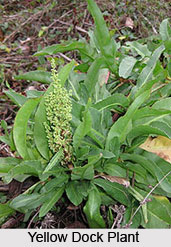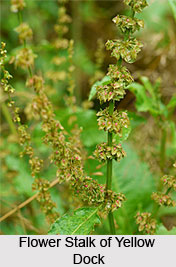 Yellow Dock is a perennial flowering plant which is also popular as curled dock or curly dock. It belongs to the family Polygonaceae and Rumex crispus is its biological name. The inflorescence or flower stalk of the plant rises to a height of 1 metre. It has a large basal rosette from where smooth leaves emerge out having distinct waved or curled edges. Flowers and seeds grow in clusters on the stalk and branched stems and the largest cluster is found at the apex. The seeds of the plant have a shiny brown appearance and are encased in the flower calyx where they are produced. This encasing helps in the dispersion of seeds. The root of Yellow Dock is yellow, large and forking taproot. The plant has several subspecies which thrive in varied habitats.
Yellow Dock is a perennial flowering plant which is also popular as curled dock or curly dock. It belongs to the family Polygonaceae and Rumex crispus is its biological name. The inflorescence or flower stalk of the plant rises to a height of 1 metre. It has a large basal rosette from where smooth leaves emerge out having distinct waved or curled edges. Flowers and seeds grow in clusters on the stalk and branched stems and the largest cluster is found at the apex. The seeds of the plant have a shiny brown appearance and are encased in the flower calyx where they are produced. This encasing helps in the dispersion of seeds. The root of Yellow Dock is yellow, large and forking taproot. The plant has several subspecies which thrive in varied habitats.
Ecology of Yellow Dock
Yellow Dock grows extensively in a vast variety of habitats like forest edges, shorelines, fields or meadows, roadsides, waste areas and disturbed soil. It is regarded to be an invasive species in many areas. The plant spreads through the dispersion of seeds via contamination with crop seeds and sticking to clothing.
Medicinal Uses of Yellow Dock
 Roots of Yellow Dock plant are effective in treating anaemia owing to the presence of abundant amount of iron. The roots can be administered by powdering and then giving in capsules, sometimes in combination with stinging nettle - Urtica dioica. The combination is very effective. In some individuals, both the roots and leaves may have mild laxative effect. This owes to its content of anthroquinone glycosides. However, the plant may result in intestinal discomfort in certain cases. It also affects the skin when taken internally or applied externally over areas of itching, sores and scrofula. Several homeopathic medicines use Yellow Dock as an important ingredient. It is also effective in treating respiratory conditions. A poultice of the powdered root is curative when applied to rashes, sores and skin infections. Infusion of the root is helpful in treating athlete`s foot.
Roots of Yellow Dock plant are effective in treating anaemia owing to the presence of abundant amount of iron. The roots can be administered by powdering and then giving in capsules, sometimes in combination with stinging nettle - Urtica dioica. The combination is very effective. In some individuals, both the roots and leaves may have mild laxative effect. This owes to its content of anthroquinone glycosides. However, the plant may result in intestinal discomfort in certain cases. It also affects the skin when taken internally or applied externally over areas of itching, sores and scrofula. Several homeopathic medicines use Yellow Dock as an important ingredient. It is also effective in treating respiratory conditions. A poultice of the powdered root is curative when applied to rashes, sores and skin infections. Infusion of the root is helpful in treating athlete`s foot.
Other Uses of Yellow Dock
Yellow Dock can be consumed as a wild leaf vegetable after boiling the young leaves several times for removing the major amount of oxalic acid present in them. Moderate amounts of leaves can also be served directly as salads. Mature leaves are bitter to consume. Yellow Dock leaves are rich in iron, potassium, proteins and vitamin A. However their tartness is owing to the presence of high levels of oxalic acids. Over consumption of these leaves can cause irritation in the urinary tract and raises the risk of developing kidney stones. Its consumption during lactation should me strictly monitored as it can result in laxative effect in the infant.



















